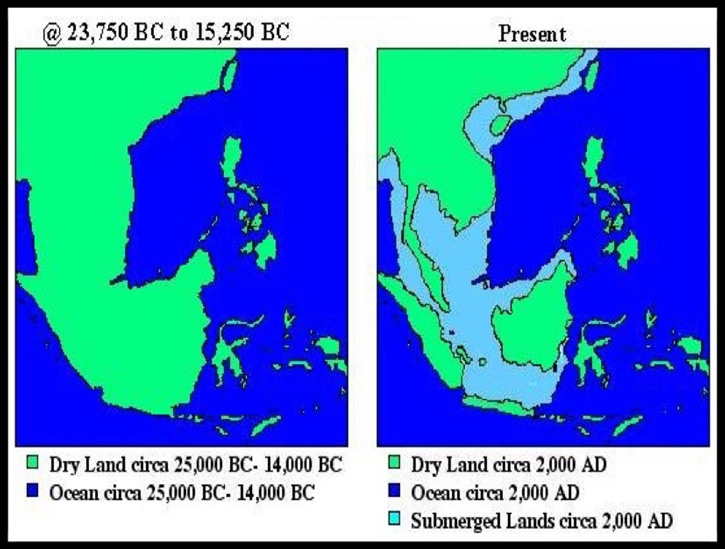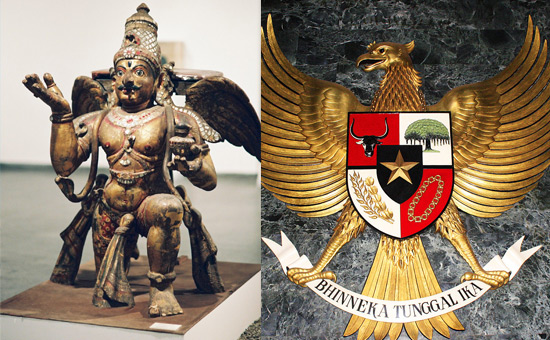-
Article tells about
the presence of Sanskrit words in Indonesian language - Bhasha.
“(… the archeological evidence) confirms the origin of Civilisation and even of humanity itself in the Indies…. that is, India and Indonesia…” Prof. Arysio Nunes dos Santos in "Atlantis, the Lost Continent Finally Found”.
To date, "Sanskrit in
Indonesia” by Dr. J. Gonda, Professor of Sanskrit and Indonesia Linguistics,
Utrecht (Holland) remains one of the most often quoted work on the subject. No
doubt, it is an interesting read.
The Professor must
have spent years researching the subject, not to miss the time and energy spent
on learning the fineries and subtleties of the languages and the idioms. As any
other professor and researcher before 1950s, he too starts with the premise
that the Indonesian Archipelago, or Dvipantara as it was known in the ancient times, was influenced by India, thus coining the phrase "Indian Cultural Colonization” of the archipelago.
Almost seven decades
after the publication of Dr. Gonda’s work in the year 1952, this premise is now being challenged.
The New Technology, satellite pictures, archeological findings, etc.
prove beyond any doubt that there was no such thing as cultural invasion and
colonization.
Beyond their current
political boundaries, the Indian Subcontinent in its entirety and the
Indonesian/Malaysian Archipelago - were once connected and not separated by the
seas.
Let us consider the following points to understand our
history, or rather histories better:
Sundaland, a name coined
to identify a large chunk of Southeast Asian landmass submerged by rising sea
levels between 15,000 and 3,000 BC.
Interestingly, the
word Sunda means
Elephant Trunk in several Prakrit or natural languages as the
predecessor of Sanskrit. Please look at the picture here, it does look
like an Elephant Trunk.

As the Result, over a Period of about
9,000 Years before the gradual submergence of most of its
landmass, the peoples of Sundaland migrated to safer places.
What does this imply? We are talking about the migration of the peoples of Svarnabhumi (Sanskrit, the Land of Gold), the Yavan (Prakrit/Sanskrit for Yava or Barley Growers) upward, northward, to the modern state of Bengal, even beyond…. Perhaps, even beyond the mighty Sindhu River. The Greek are referred to as Yavan in several Sanskrit texts.
In his book "Eden in the East”, British Geneticist and Expert in DNA Studies Prof. Stephen Oppenheimer (1947) wrote, “Southeast Asia (is) the source of the elements of Western civilisation.”
The Later
Fragmentation of Sundaland due to natural
disasters created what became known as Yavadvipa, the Barley Island.
Currently, the most populated island in the Indonesian Archipelago is Pulau
Jawa - the Island of Jawa.
It got separated from
the island now called Sumatra (Prakrit/Sanskrit, meaning the Island of Precious
Metal, Gold) and is today the second most populated island in the Indonesian
Archipelago.
A proper
understanding of this history is important so as to appreciate the common
cultural roots, the samskriti that we all share. For, it is this very samskriti, our
common cultural roots, our natural history that gave rise to the Prakrit or
Natural Languages, and, later Sanskrit as a language to unite us all.
Sanskrit, as the Very Term
Indicates, is a refined, polished,
customized language absorbing words from Prakrit or Natural Languages. Later,
in the 6th to 5th century B.C., the great grammarian Panini codified the
language.
His work Ashtadhyayi
is considered the first ever treatise on the grammar. Yes, that is correct, on
the grammar of any language. Around the same time, a script was also developed,
i.e. the Devanagari Lipi, to complement the language and its grammar.
Coming back to
Dvipantara or the modern Indonesian Archipelago, several of the older languages
here like Javanese (also spelled Jawanese) and Balinese still retain the traces
of Brahmi Lipi or Script that precedes the popular Devanagari Script today.
We are Aware
of the Ongoing Debate on whether
Sanskrit is older than the Prakrit languages or the vice versa. This will
continue until the Sanskrit scholars and experts on languages look beyond the
borders of Bharat, not to speak of the present state of India, and study the
languages of ancient Persia, Dvipantara, and other regions sharing the same Sanatani,
same Dharmika roots.
Without entering into
an unnecessary debate, if we focus on the similarities of the lofty customs and
traditions, or the samskriti of the vast region referred to as the Jambudvipa in
the ancient times - we can easily conclude that, indeed, the entire region from
ancient Persia to the outer limits of Australia, and even beyond, sprouted from
the same cultural and civilizational heritage.
 Angkasa in Bhasha Indonesian or Akasha in Sanskrit/Hindi.
Angkasa in Bhasha Indonesian or Akasha in Sanskrit/Hindi.
Let some now examine some very common words in Bahasa (Bhasha)
Indonesia having similarities with modern Sanskrit and Hindi words:
1. Agama meaning Religion, and Aagama meaning
Traditional Doctrine.
2. Ananda and Nandana - Son
3. Angka and Anka - both meaning Number
4. Angkasa and Akasha - Sky
5. Arti and Artha – Meaning.
6. Bahagia meaning Happy, and Bhagya meaning Good
Fortune
7. Bahaya meaning Danger, and Bhaya meaning Fear
8. Baruna and Varuna, both meaning the Lord of
Waters
9. Bayu and Vayu, both meaning the Lord of Winds
10. Biji and Bhija, both meaning Seed.
11. Cempaka and Campaka - Magnolia Flower
12. Cendana and Chandana, both meaning
Sandalwood
13. Cerita and Carita - Story
14. Citra in Indonesian means Image, in Sanskrit it means
Picture
15. Dana and Dhana – Money.
16. Desa in Indonesian - Village; Desha in
Sanskrit - Country
17. Dirgahayu and Dhirga Aayu - Long Live
18. Duka and Dukha - Sadness/Pain
19. Eka in both Sanskrit and Javanese means One or Mono
20. Esa in Ancient Javanese and Indonesian - Mighty; Isha in Sanskrit – Lord.
 National symbol of Indonesia is Garuda. Every Vishnu temple has Garuda.
National symbol of Indonesia is Garuda. Every Vishnu temple has Garuda.
21. Gajah and Gaja, both meaning Elephant
22. Garuda in both Sanskrit and Indonesian means
Eagle-like Legendary Bird
23. Genta in Indonesian and Ghanta in Sanskrit -
Bell
24. Gerhana in Indonesian and Grahana in Sanskrit -
Eclipse
25. Gita in both Indonesian and Sanskrit – Song.
26. Graha in both Indonesian and Sanskrit - House or
Mansion
27. Guru in both Sanskrit and Indonesian means Teacher
28. Hasta in both Sanskrit and Indonesian - Hand
29. Husada or Usada in Indonesian and Aushadha
in Sanskrit means Medicine
30. Indra in Indonesian and Indriya in Sanskrit -
Sense Organ.
31. Isteri or Istri and Stri in both
Indonesian and Sanskrit - Woman
32. Jagat in both the languages - Universe
33. Ja(a)la(a) in Indonesian, and Jaala in Sanskrit
- Net
34. Jiwa and Jiva - Individual Soul
35. Jaya in both - Hail, Glorious, Victory.
36. Ka(a)ca(a) in Indonesian and Kaacha in Sanskrit - Glass
37. Kala in both - Time
38. Kencana and Kanchana - Gold
39. Kendi in Indonesian and Kundi in Sanskrit -
Pitcher
40. Loba and Lobha – Greed.
41. Madya and Madhya - Middle
42. Manusia and Manushya - Human being
43. Neraka and Naraka - Hell or Underworld
44. Pustaka in both the languages - Book
45. Pertiwi and Prithvi – Earth.
46. Rasa in both can mean Taste, Emotion, or Flavor
47. Samudra in both - Ocean
48. Tri in both - Three
49. Utama and Uttama - Most Important
50. Wahana and Vaahana - Vehicle
51. Yudha and Yuddha – War.
Out of
25,000+ Entries in the
Kawi (Old Javanese) - English Dictionary by Prof. P.J. Zoetmulder, S.J. (1982),
almost half are mistakenly referred to as Sanskrit Loanwords. They actually
stem from the same Prakrit roots as Sanskrit.
Most of these words
are found in the modern Bahasa Indonesia. And, they are not perceived as words
of foreign origin.
Similarly, as
mentioned earlier, the samskriti, the values held high by modern Indonesians to date
bear witness to our common roots, culture and civilization.
About the Author - Proud of his Sindhi-Indian ancestry rooted in the Glorious Sindhu Civilization and Culture Anand Krishna was born in Solo (Central Java), and is his Karma Bhumi, his work field. Beside the mother Organization, Anand Ashram Foundation (affiliated with UN), Anand Krishna has inspired several other social and educational institutions. The 4th President of Indonesia, KH Abdurrahman Wahid recognized his contributions and said, “If we want to have peace, then we must hear what Anand Krishna is saying”. He has a legacy of 180+ books to date with more than 1.5 million copies sold in the past 20 years. Anandji has an ashram in Ubud, Bali.
Also read
1 What
is Samskriti
2 Ganesha
Temples in Indonesia
3 History
of Sanskrit
4 Architecture
of Indonesian Shiva Mandir in Prambanan